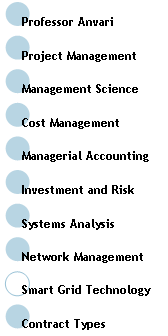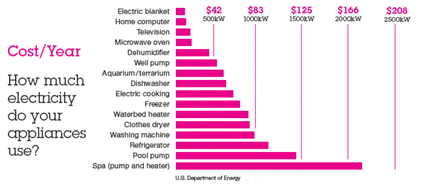


|
education & consulting in |

|
Smart Grid Technology |

What is Smart GridThe function of an Electrical grid is not a single entity but an aggregate of multiple networks and multiple power generation companies with multiple operators employing varying levels of communication and coordination, most of which is manually controlled. Smart grids increase the connectivity, automation and coordination between these suppliers, consumers and networks that perform either long distance transmission or local distribution tasks. Transmission networks move electricity in bulk over medium to long distances, are actively managed, and generally operate from 345kV to 800kV over AC and DC lines. Local networks traditionally moved power in one direction, "distributing" the bulk power to consumers and businesses via lines operating at 132kV and lower.
This paradigm is changing as businesses and homes begin generating more wind and solar electricity, enabling them to sell surplus energy back to their utilities. Modernization is necessary for energy consumption efficiency, real time management of power flows and to provide the bi-directional metering needed to compensate local producers of power. Although transmission networks are already controlled in real time, many in the US and European countries are antiquated[11] by world standards, and unable to handle modern challenges such as those posed by the intermittent nature of alternative electricity generation, or continental scale bulk energy transmission. |
|
A smart grid delivers electricity from suppliers to consumers using two-way digital technology to control appliances at consumers' homes to save energy, reduce cost and increase reliability and transparency. It overlays the electricity distribution grid with an information and net metering system. Such a modernized electricity network is being promoted by many governments as a way of addressing energy independence, global warming and emergency resilience issues. Smart meters may be part of a smart grid, but alone do not constitute a smart grid. The smart grid is made possible by applying sensing, measurement and control devices with two-way communications to electricity production, transmission, distribution and consumption parts of the power grid that communicate information about grid condition to system users, operators and automated devices, making it possible to dynamically respond to changes in grid condition.
A smart grid includes an intelligent monitoring system that keeps track of all electricity flowing in the system. It also incorporates the use of superconductive transmission lines for less power loss, as well as the capability of integrating renewable electricity such as solar and wind. When power is least expensive the user can allow the smart grid to turn on selected home appliances such as washing machines or factory processes that can run at arbitrary hours. At peak times it could turn off selected appliances to reduce demand. Similar proposals include smart electric grid, smart power grid, intelligent grid (or intelligrid), FutureGrid, and the more modern intergrid and intragrid. |
Smart grid functionsBefore examining particular technologies, a proposal can be understood in terms of what it is being required to do. The governments and utilities funding development of grid modernization have defined the functions required for smart grids. According to the United States Department of Energy's Modern Grid Initiative report[24], a modern smart grid must:
1. Be able to heal itself 2. Motivate consumers to actively participate in operations of the grid 3. Resist attack 4. Provide higher quality power that will save money wasted from outages 5. Accommodate all generation and storage options 6. Enable electricity markets to flourish 7. Run more efficiently 8. Enable higher penetration of intermittent power generation sources |
|
"Smart Grid Cities," 2010 Tufts Energy Conference (tuftsenergyconference.com/schedule), April 17, 2010, Medford, Massachusetts
"Cyber and Critical Infrastructure Security: Toward Smarter and More Secure Power and Energy Infrastructures," Canada-U.S. Workshop on Smart Grid Technologies, March 25, 2010, Vancouver, BC
"Smart Grid: Toward stronger, smarter, and more secure energy infrastructure," Presentation at the Minnesota Senate Energy, Utilities, Technology & Communications Committee, Tuesday, 3:00-5:30 p.m., February 16, 2010
"The Smart Grid Landscape: What's on the Horizon?" keynote address at the workshop "Putting Minnesota on the Map: Building a Smart Grid Coalition in Minnesota" co-sponsored by the Minnesota Office of Energy Security, IREE, and the Institute on The Environment, University of Minnesota, November 18, 2009
"Globalization, Energy, and Growth: Exploring and understanding implications of "The World is Flat" for science- and technology-intensive organizations and what that means for individuals, organizations, innovation, R&D, and opportunities for growth," Signature Series Summit, Tuesday, 8:30-4:30, October 27, 2009
"Toward Resilient, Smart and Self-healing Interdependent Infrastructures," keynote address at the TCLEE 2009, the 7th Lifeline Earthquake Engineering in a Multi-Hazard Environment International Conference, Oakland, CA, June 30, 2009
"Making the Electric Power Grid Smarter, Stronger, Greener, and More Secure," webinar delivered to over 500 registered individuals and organizations, June 23, 2009
"Smart Grid: Opportunities and Challenges - Toward a Stronger and Smarter Grid," keynote at the Smart Grid workshop sponsored by Sandia National Laboratories at the MIT Energy Conference 2009, Cambridge, Massachusetts, March 6, 2009 |


